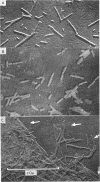Abstract
The protein obtained when tobacco mosaic virus is disrupted with alkali is antigenically heterogeneous, whereas the intact virus is homogeneous. Aggregating the protein by acidification makes it again antigenically homogeneous. In comparable conditions, antibody/antigen ratio is considerably higher in precipitates formed by the protein than in those formed by the virus. Aggregating the protein restores the ratio to that given by the original virus.
Electron-microscopic examination shows that in extreme antibody excess each virus particle is covered with a layer of antibody molecules. In these conditions, therefore, individual antibody molecules seem not to bridge directly between different virus particles, but they may do so in the zone of equivalence.
Full text
PDF











Images in this article
Selected References
These references are in PubMed. This may not be the complete list of references from this article.
- HOLMES K. C., FRANKLIN R. E. The radial density distribution in some strains of tobacco mosaic virus. Virology. 1958 Oct;6(2):328–336. doi: 10.1016/0042-6822(58)90086-2. [DOI] [PubMed] [Google Scholar]
- KLECZKOWSKI A. A preliminary study of tobacco mosaic virus by the gel diffusion precipitin tests. J Gen Microbiol. 1957 Apr;16(2):405–417. doi: 10.1099/00221287-16-2-405. [DOI] [PubMed] [Google Scholar]
- KLECZKOWSKI A. An electrophoretic study of the mechanism of precipitin reactions: variation in reversibility. Immunology. 1959 Apr;2(2):97–103. [PMC free article] [PubMed] [Google Scholar]



